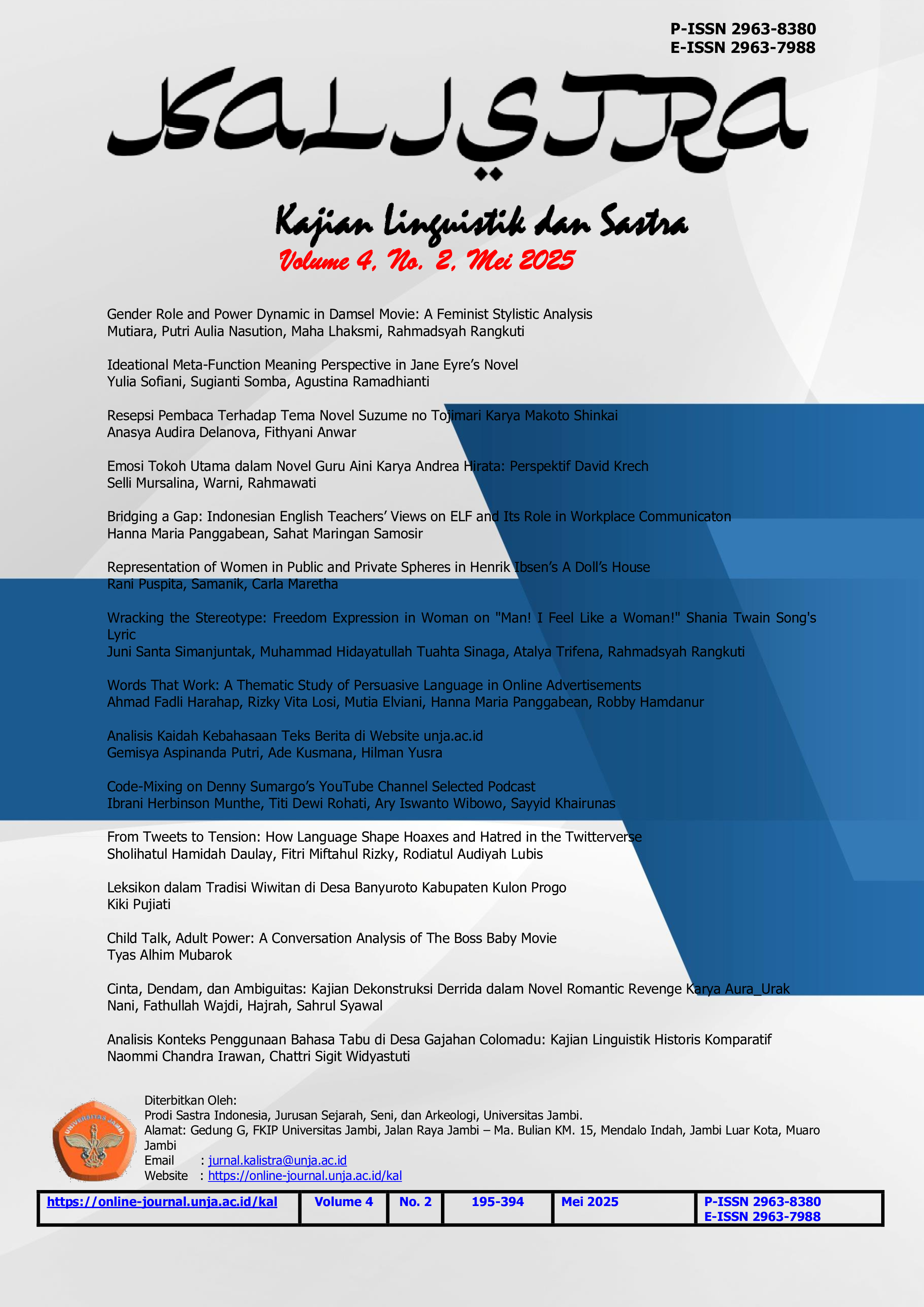Gender Role and Power Dynamic in Damsel Movie: A Feminist Stylistic Analysis
DOI:
https://doi.org/10.22437/kalistra.v4i2.42878Keywords:
Damsel, Movie, Gender, Power, Feminist stylisticsAbstract
his research aims to analyze Damsel (2024), a movie related to gender role and power dynamic that analyzed through the lens of feminist stylistics. This research uses descriptive qualitative approach and conducted into three levels: word level, phrase/sentence level, and discourse level, following the frame of feminist stylistics introduced by Sara Mills (1995). At the word level, strong and assertive language is used by female characters, particularly Elodie and the stepmother, to resist patriarchal oppression. At the sentence level, active sentence structures position Elodie as the driving force of the narrative rather than a passive victim. At the discourse level, the film challenges the trope of the helpless princess and instead presents a protagonist who fights for justice and subverts traditional power dynamics. In conclusion, the feminist stylistic analysis of Damsel (2024) movie reveals that the film actively dismantles gender role and power dynamic by using language and character interactions.
Abstrak
Penelitian ini bertujuan untuk menganalisis Damsel (2024), sebuah film yang berkaitan dengan peran gender dan dinamika kekuasaan yang dapat dianalisis melalui lensa stilistika feminis. Penelitian ini menggunakan pendekatan kualitatif deskriptif untuk mengkaji analisis. Analisis dilakukan dalam tiga level: level kata, level frasa/kalimat, dan level wacana, mengikuti kerangka stilistika feminis yang diperkenalkan oleh Sara Mills (1995). Pada level kata, bahasa yang kuat dan tegas digunakan oleh tokoh-tokoh perempuan, khususnya Elodie dan ibu tiri, untuk melawan penindasan patriarki. Pada level kalimat, struktur kalimat aktif memposisikan Elodie sebagai penggerak narasi, bukan sebagai korban yang pasif. Pada tingkat wacana, film ini menantang kiasan putri yang tak berdaya dan sebagai gantinya menampilkan tokoh protagonis yang memperjuangkan keadilan, dan menumbangkan dinamika kekuasaan tradisional. Kesimpulannya, analisis gaya bahasa feminis terhadap film Damsel (2024) menunjukkan bahwa film ini secara aktif membongkar peran gender dan dinamika kekuasaan dengan menggunakan bahasa dan interaksi karakter.
Downloads
References
Br Pane, K. J., Lubis, S., Rangkuti, R., & Br Perangin – Angin, A. (2024). Gendered Linguistic Analysis of Jane Austen’s “Emma”: Unveiling Feminist Perspectives at the Word Level. EduLite: Journal of English Education, Literature and Culture, 9(1), 61. https://doi.org/10.30659/e.9.1.61-81
Butler, J. (1988). Performative Acts and Gender Constitution: An Essay in Phenomenology and Feminist Theory. In Theatre Journal (Vol. 40, Issue 4). http://www.jstor.org/about/terms.html.
Fathallah, J., & Pyakurel, P. (2020). Addressing gender in energy studies. Energy Research and Social Science, 65(101461). https://doi.org/https://doi.org/10.1016/j.erss.2020.101461
Foucault, M. (1983). Subject and Power. In Michel Foucault: Beyond Structuralism and Hermeneutics (pp. 208–226). Chicago: The University of Chicago Press. https://doctoradohumanidades.wordpress.com/wp-content/uploads/2015/04/dreyfus-michel-foucault-beyond-structuralism-and-hermeneutics.pdf
Gadis Deameysa, H., Sari, D. L., Ningsih, D. L., Khofifah, I., & Elviona. (2023). A Feminist Stylistic Analysis in Taylor Swift’s Song “The Man.” Journal of Literature Language and Academic Studies, 2(03), 86–91. https://doi.org/10.56855/jllans.v2i03.849
Grevin, C. (2022). From Preachers to Political Activists: Women in the Public Sphere during the Second Great Awakening, 1830-1840. 14(4). https://digitalcommons.chapman.edu/vocesnovae/vol14/iss1/4
Khan, M., & Mehmood, S. (2023). Representation Of Headless Women: A Feminist Stylistic Analysis Of Visuals In Hollywood Movie Posters. Educational Administration: Theory and Practice, 2023(4), 2472–2484. https://doi.org/10.53555/kuey.v29i4.7181
Kiram, M. Z. (2024). Interrogating masculinity, gender performance, and power dynamics in Indonesian society through Taylor Swift’s ‘The Man.’ Gender Equality: International Journal of Child and Gender Studies, 10(2), 209. https://doi.org/10.22373/equality.v10i2.25877
Liderman Panggabean, Y., & Saragih, M. W. (2024). Instrumentality Of Women In Damsel Movie (2024). Dialektika, 1(1), 26–35. https://doi.org/https://doi.org/10.33541/dia.v11i1.6029
Lu’luil Maknun, Rimajon Sotlikova, & Elysa Hartati. (2023). Women’s Discrimination Of Beauty Is A Wound: Feminist Stylistics Approach Of Sara Mills. Literature and Literacy, 1(2), 95–109. https://doi.org/10.21831/litlit.v1i2.28
McArthur, T. (1996). The Oxford Companion to the English Language (T. McArthur, Ed.). Oxford University Press. https://books.google.co.id/books/about/The_Oxford_Companion_to_the_English_Lang.html?id=eISV4Z-jim4C&redir_esc=y
Rahimnouri, Z., & Ghandehariun, A. (2020). A Feminist Stylistic Analysis of Doris Lessing’s The Fifth Child (1988). Journal of Language and Literature, 20(2), 221. https://doi.org/10.24071/joll.v20i2.2586
Sarah Mills. (1995). Feminist Stylistics (1st ed.). Routledge. https://www.taylorfrancis.com/books/mono/10.4324/9780203408735/feminist-stylistics-sara-mills
Zahra Tarigan, A., Basa Tambunan, C. U., Melati, L., Mentari, S., & Rangkuti, R. (2023). Feminist Stylistic Analysis of Bella Poarch’s Song “Build A Bitch.” Linguistics and English Language Teaching Journal, 11(2), 119–130. https://journal.ummat.ac.id/index.php/JELTL/article/view/20134#:~:text=The%20findings%20show%20an%20advanced,to%20women.%20The%20song%20arises
Downloads
Published
How to Cite
Issue
Section
License
Copyright (c) 2025 Mutiara Mutiara, Putri Aulia Nasution, Maha Lhaksmi, Rahmadsyah Rangkuti

This work is licensed under a Creative Commons Attribution-ShareAlike 4.0 International License.
Kalistra: Kajian Linguistik dan Sastra is licensed under Creative Commons Attribution-ShareAlike 4.0 International License.
Authors who publish their manuscripts in Kajian Linguistik dan Sastra agree to the following terms:
1. The copyright in each article belongs to the author.
2. The author acknowledges that Kajian Linguistik dan Sastra reserves the right to be the first to publish under a Creative Commons Attribution-ShareAlike 4.0 International License (Attribution 4.0 International CC BY-SA 4.0).
3. Authors may submit articles separately, arranging for non-exclusive distribution of manuscripts that have been published in this journal to other versions (e.g., delivery to the author's institutional repository, publication into a book, etc.), acknowledging that the manuscript has been first published in Kajian Linguistik dan Sastra.
















